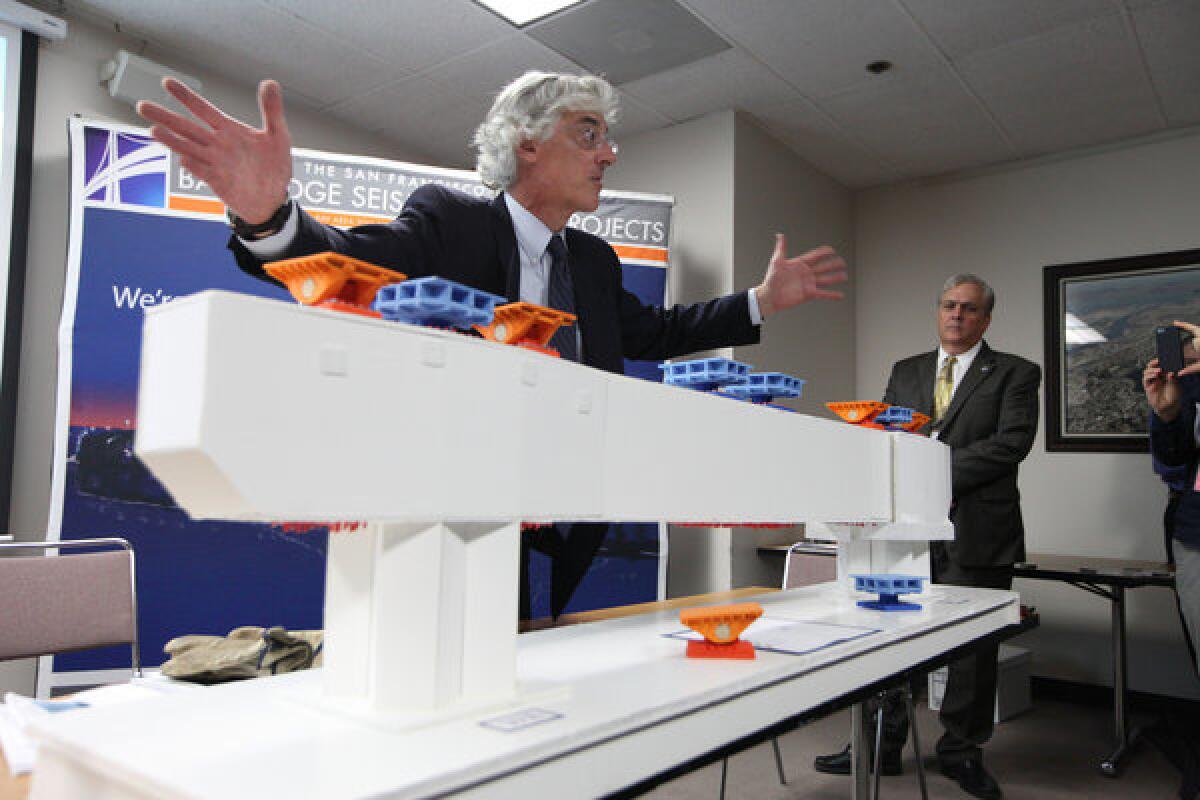Officials plan $10-million fix for broken bolts on new Bay Bridge

- Share via
OAKLAND — State and regional transportation officials Wednesday announced plans for a retrofit to the new eastern span of the San Francisco-Oakland Bay Bridge that will cost up to $10 million and effectively do the job of three dozen massive bolts that snapped unexpectedly earlier this year.
Questions remain, however, about whether the world’s largest single-tower self-anchored suspension span will open on Labor Day weekend as expected. The new span will replace the one that partially collapsed in the 1989 Loma Prieta earthquake.
“We believe the work can get done by Labor Day, but it will require extra shifts and perhaps a 24-hour-a-day operation and that will cost more money,” Metropolitan Transportation Commission Executive Dirctor Steve Heminger told the Bay Area Toll Authority Oversight Committee.
The thick steel bolts — which are 17 feet to 24 feet long — connect the bridge deck to so-called shear keys, which are designed to control movement during an earthquake. They were part of a batch manufactured and galvanized in 2008 and installed on the span, which has been in the works for decades at an ever-ballooning cost of $6.4 billion.
When the 96 bolts, which were embedded in concrete and impossible to remove, were tightened earlier this year, a third of them broke, leaving the seismic safety of the massive endeavor in question.
That batch of bolts have been deemed too compromised to rely on.
The “wild card,” Heminger said, is whether bolts made from similar steel in 2010 — some equally large and some much smaller — will also have to be replaced before the bridge opens or simply monitored after the fact.
Commissioners on Wednesday were filled in on the planned retrofit as well as a battery of tests being conducted on the bolts made in 2010.
In addition to Heminger, presenters included California Transportation Commission Executive Director Andre Boutros and California Department of Transportation Director Malcolm Dougherty. The three organizations jointly oversee the bridge project.
Boutros said the group had opted for one of two finalists for the retrofit — a steel saddle that must be fabricated and will be clamped down on top of the shear key plates with tensioned cables. Another option, for a larger steel collar, would have cost up to $20 million.
The officials will brief the Bay Area Toll Authority again at the end of the month on the results of tests on the 2010 batch of bolts, which so far have not broken and would be easier to replace if that were necessary. They authority will then make a decision on whether to delay the bridge opening — and a massive party already in the planning.
The three of agencies have retained three independent experts to review the problems and have also asked the Federal Highway Administration to conduct an external review.
“I thnk we’re dealing here with not just engineering concerns but public confidence and I think that public confidence has taken a beating ofver the past few weeks,” Heminger said.
Caltrans has come under fire for using the galvanized steel bolts, as industry standards and Caltrans’ own guidelines warn against galvanizing the specific grade of steel used due to its hardness and tendency to break under extreme tension.
The massive bolts failed due to a phenomenon called hydrogen embrittlement, in which hydrogen atoms invade the spaces between the steel’s crystalline structure and weaken it. That may have occurred during galvanization, or when the bolts for years sat untightened in casings that filled with water.
Caltrans has said that it asked the manufacturer to use a galvanization process less likely to cause hydrogen embrittlement but in retrospect should have tested the bolts more thoroughly in the lab before installing them.
When asked why Caltrans deviated from its own specifications, which warn against galvanizing this type of steel, Caltrans Deputy Toll Bridge Manager Brian Maroney said in his 25 years of bridge engineering “every single project has special provisions, because those standards don’t really fit and you have to come up with a technical solution.
“The Bay Bridge,” he added, “has many many many special deviations away from the standard.”
ALSO:
Victims in plane crash after midair collision identified
Sikh man, 82, beaten in Fresno in apparent hate crime
Carmen Trutanich endorses by ex-City Atty. Rocky Delgadillo
Twitter @leeromney
More to Read
Sign up for Essential California
The most important California stories and recommendations in your inbox every morning.
You may occasionally receive promotional content from the Los Angeles Times.














